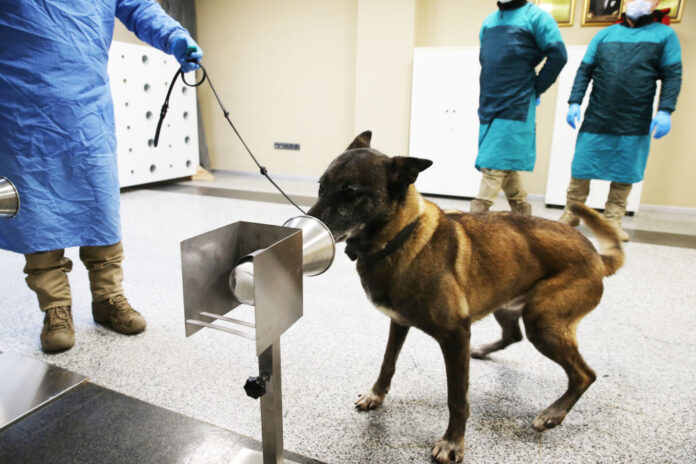A French study that was published Wednesday in the journal Plos One has found further evidence that dogs trained to sniff out COVID-19 infections are highly accurate.
The group of dogs used in the French study sniffed sweat samples from humans and were able to accurately identify 97 per cent of positive COVID-19 cases and 91 per cent of negative cases.
“The sensitivity of canine detection was higher than that of nasopharyngeal antigen testing (rapid tests),” the results of the study read. The authors of the paper found that rapid tests were only 84 per cent effective at detecting positive cases. However, rapid tests were better at detecting negative cases, at 97 per cent.
So, while rapid tests provided more false negatives, sniffer dogs were more prone to false positives. Dominique Grandjean, a lead author of the study and professor at the Alfort National Veterinary School in France, said that sometimes the sniffer dogs mistook other respiratory infections for COVID-19.
Another interesting find was that sniffer dogs were particularly good at detecting asymptomatic cases of COVID-19. In this study, sniffer dogs achieved a 100 per cent accuracy rate at detecting asymptomatic positive cases.
For the study, sweat samples from 335 adults were collected at community centres in Paris, 109 of whom tested positive for COVID-19 when assessed with a PCR test.
These samples were then placed in a small box with a cone sticking out of it for the dogs to stick their noses in. If a dog detected a positive case of COVID-19, it was trained to sit down.
The study jokingly noted that both the dog handlers “and the dogs” were blind to the COVID-19 status of a sample before testing.
The researchers sourced dogs from French fire departments and the Ministry of the Interior of the United Arab Emirates (UAE). The dogs were trained at detection using toys — usually tennis balls — as rewards for correct identification.
“It’s playtime for them,” Grandjean told Science News.
Trending Stories
Woman gored by bison, tossed 10 feet in the air at Yellowstone park
4 people killed, gunman dead after mass shooting at Tulsa medical centre: police
Dogs already trained in some form of scent detection only take about three weeks of practice to detect COVID-19 while dogs with no prior experience can learn in five to six weeks.
The study was conducted in early 2021, so the dogs were detecting the original COVID-19 virus.
An earlier study done in the U.K., published on March 24, found similar results.
Grandjean told NBC News he’s begun to examine the dogs’ abilities at detecting variants.
He also said that the findings of his study suggest that dogs would be useful for quick COVID-19 detection for large crowds, such as in airports, schools, nursing homes and sporting events. Dogs have already been used for COVID-19 detection in airports in Finland, Saudi Arabia and the UAE.
The study claims dogs are a great alternative to rapid tests not only because of their accuracy but speed as well. Grandjean estimated that it only took 15 seconds for a trained dog to analyze 20 COVID-19 samples.
Sniffer dogs are also much less invasive than nasal or throat swabs, which can be painful and anxiety-inducing for some.
Incredibly, Grandjean noted that there is anecdotal evidence to suggest that a person who tests negative on a PCR test but positive based on sniffer dog detection will likely test positive on a PCR test two days later.
Read more:
Amber Heard lawyer claims Johnny Depp ‘demonized’ ex-wife, suppressed evidence in defamation trial
While the prospect of COVID-19 detection dogs is exciting, the likelihood that they will be used widespread is slim.
In the real world, outside of laboratory conditions, it would be difficult to train dogs to get to the same level of accuracy, according to Dr. Cynthia Otto, director of the Penn Vet Working Dog Center at the University of Pennsylvania.
“The ideal — and I would consider it the Holy Grail — is that the dog is just standing there, a person walks by, and they say, ‘Yes, no, yes, no, yes, no,’” Otto told NBC News. “That eventually could be done, but making sure it’s done with all the proper controls and quality assurances and safety — it’s a big step. I haven’t seen anyone who has proposed how to make that transition in a way that’s scientific and safe.
“That’s one of the big challenges — to have the dog learn to translate from a sample to an entire human being, which is a much more complex odour,” she said.
© 2022 Global News, a division of Corus Entertainment Inc.



